HP HPE6-A45 Exam Practice Questions (P. 5)
- Full Access (173 questions)
- Six months of Premium Access
- Access to one million comments
- Seamless ChatGPT Integration
- Ability to download PDF files
- Anki Flashcard files for revision
- No Captcha & No AdSense
- Advanced Exam Configuration
Question #21
Refer to the exhibit.
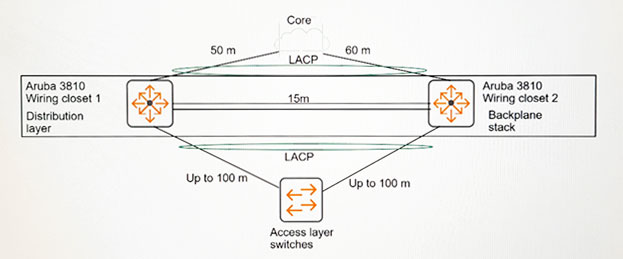
A company requires distribution layer switches that can provide Layer 2 and Layer 3 redundancy. The exhibit shows the proposal for these switches. Which change to the proposal will help meet the company's requirements?

A company requires distribution layer switches that can provide Layer 2 and Layer 3 redundancy. The exhibit shows the proposal for these switches. Which change to the proposal will help meet the company's requirements?
- AThe proposed switches should be replaced with switches such as the Aruba 2930M to support the backplane stacking technology.
- BVRRP should be implemented instead of backplane stacking to support the Layer 3 redundancy requirements.
- CLink aggregations should be established without LACP to support the Layer 2 redundancy requirements and backplane stacking limitations.
- DThe proposed switches should be replaced with switches that support VSF to support the required distance between stack members.
Correct Answer:
C
C
send
light_mode
delete
Question #22
Network administrators need to track when traffic matches deny entry in an ACL applied to a port. They want the alert to be sent to a syslog server that is already set up to send logs.
What should administrators do to enable alerts?
What should administrators do to enable alerts?
- ASpecify the log option for the ACL entry, and enable ACL debugging.
- BSet the debug destination to session, and enable ACL debugging.
- CEnable ACL debugging, and enable SNMP port security traps.
- DSpecify the log option for the ACL entry, and enable SNMP port security traps.
Correct Answer:
D
D
send
light_mode
delete
Question #23
Refer to the exhibits.
Exhibit 1 -
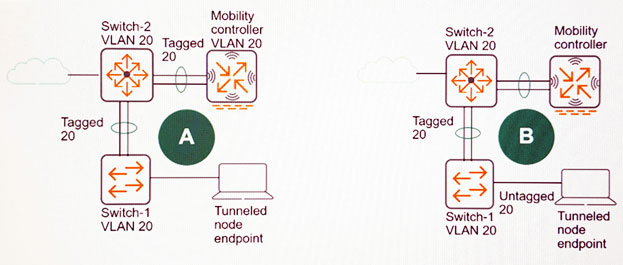
Exhibit 2 -
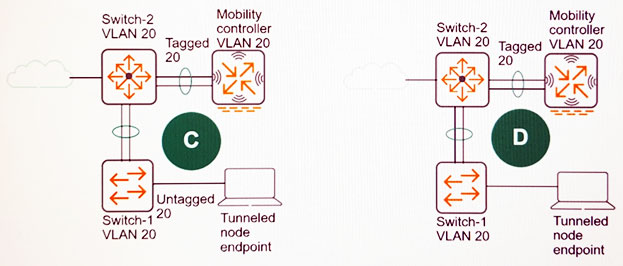
In the exhibits, VLAN 20 under a device name indicates that the device is configured with that VLAN. The exhibits also indicate whether VLAN 20 is statically configured on each link, either as an untagged or a tagged VLAN. If the link has no label, VLAN 20 is not statically configured on that link.
A network administrator needs to deploy AOS-Switches that use port-based tunneled node. The plan calls for tunneled-node endpoints to be assigned to VLAN 20 and for the Aruba Mobility Controller to handle the tunneled-node traffic at Layer 2. Which exhibit shows the correct plan for VLAN 20 in the wired infrastructure?
Exhibit 1 -

Exhibit 2 -

In the exhibits, VLAN 20 under a device name indicates that the device is configured with that VLAN. The exhibits also indicate whether VLAN 20 is statically configured on each link, either as an untagged or a tagged VLAN. If the link has no label, VLAN 20 is not statically configured on that link.
A network administrator needs to deploy AOS-Switches that use port-based tunneled node. The plan calls for tunneled-node endpoints to be assigned to VLAN 20 and for the Aruba Mobility Controller to handle the tunneled-node traffic at Layer 2. Which exhibit shows the correct plan for VLAN 20 in the wired infrastructure?
send
light_mode
delete
Question #24
Refer to the exhibits.
Exhibit 1 -
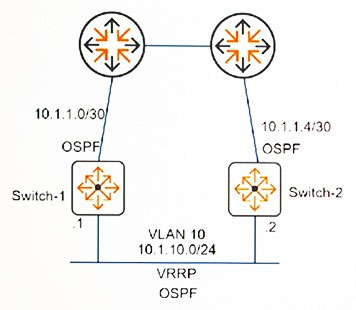
Exhibit 2 -
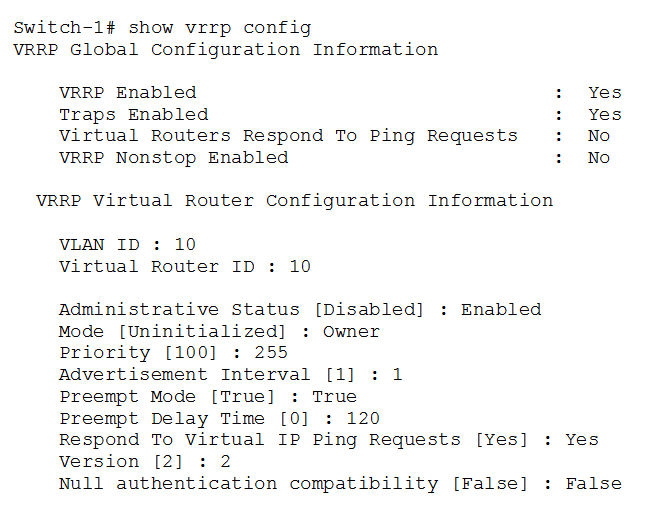
Switch-1 has a power issue that causes it to fail. When Switch-1 comes back up, endpoints lose connectivity for a few minutes. The network administrator decides to enter this command on Switch-1:
Switch-1 (config)# vlan 10 vrrp vrid 10 preempt-delay-time 120
Exhibit 2 shows the VRRP configuration just after the change. What is the effect of this change?
Exhibit 1 -

Exhibit 2 -

Switch-1 has a power issue that causes it to fail. When Switch-1 comes back up, endpoints lose connectivity for a few minutes. The network administrator decides to enter this command on Switch-1:
Switch-1 (config)# vlan 10 vrrp vrid 10 preempt-delay-time 120
Exhibit 2 shows the VRRP configuration just after the change. What is the effect of this change?
- ASwitch-1 and Switch-2 both become Master in their own VRRP virtual router due to the delay timer mismatch. The mismatch must be fixed.
- BSwitch-1 now waits to take over as Master if it fails and recovers. This should prevent the connectivity issue from occurring again.
- CSwitch-1 experiences an internal error in the VRRP process. This error causes Switch-2 to take over as Master for VLAN 2.
- DSwitch-1 continues to act as it did before the preempt delay time was set. Administrators must plan additional changes to fix the issue.
Correct Answer:
C
C
send
light_mode
delete
Question #25
Refer to the exhibits.
Exhibit 1 -
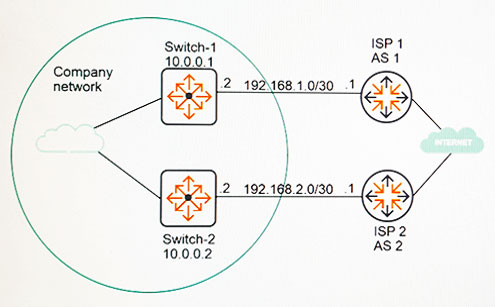
Exhibit 2 -
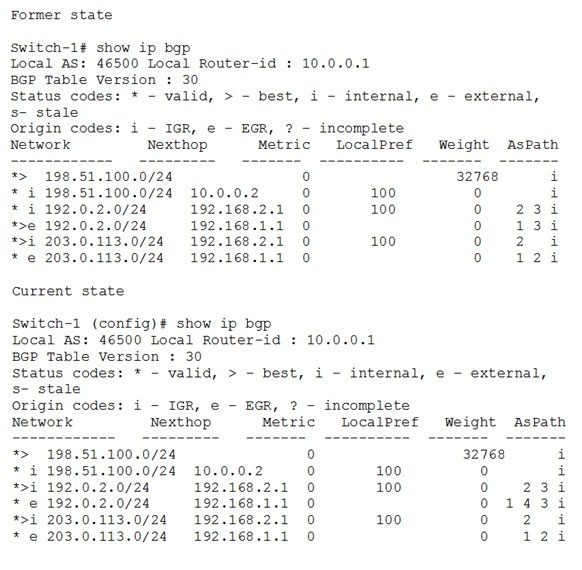
Exhibit 1 shows a portion of the BGP routing table when the BGP solution was first deployed. Exhibit 2 shows the same portion at the current time. What can explain the current state?
Exhibit 1 -

Exhibit 2 -

Exhibit 1 shows a portion of the BGP routing table when the BGP solution was first deployed. Exhibit 2 shows the same portion at the current time. What can explain the current state?
- ADue to changes in the private network, Switch-1 can no longer reach 192.168.2.1.
- BSwitch-1 can no longer reach ISP 1 at 192.168.1.1.
- CDue to changes at ISP 1, Switch-1 now selects a different best route.
- DAn administrator has applied a route map on Switch-1 that filters advertised routes.
Correct Answer:
C
C
send
light_mode
delete
All Pages
